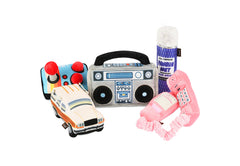Whether you’re heading to the grocery store to pick up ingredients for dinner or going on a cross-country road trip, having your canine companion with you in the car can make every driving experience more enjoyable. But, driving in the winter comes with some challenges, especially if you live in a snowy part of the country.
While it’s important to consider your own safety, you should also be thinking about the well-being of your pet when you’re driving in winter weather conditions. Keeping your furry friend safe and healthy should be a top priority if they’re a frequent traveling companion.
So, what can you do to make sure you’re taking the right precautions? How can you prepare for “the worst”, no matter how much you hope it doesn’t happen?
Let’s cover a few winter travel safety tips for you and your pet. Preparing now can mean the difference between keeping your four-legged friend safe, and exposing them to hazardous conditions.
Keep Your Car Well-Maintained
If you have a non-electronic vehicle, you should have a regular tune-up anywhere from every 10,000-12,000 miles. You should change your oil well before you hit that number, and ideally, have a mechanic look at it every few months.
Keeping your car tuned up is extremely important all year long. In the winter, however, it’s especially necessary if you plan on doing a lot of traveling. Even your commute to work could be riskier if your car isn’t safe for the road. Now, think about having your pet with you and the danger you might be putting them in if there’s an issue with your vehicle. You should make sure your car is as healthy as possible in the winter before you so much as drive down the street.
You can also do a bit of “maintenance” work yourself in the winter by:
- Keeping the exterior of your car clean and free of ice/snow
- Investing in winter tires with more tread
- Making sure your gas tank is always full
- Adding extra weight in your trunk with sandbags
Carry the Right Gear
Once you know your car is in good shape, it’s your turn to prepare. No matter the type of trip you’re going on, packing the right gear for winter travel is crucial. It’s not uncommon for people to want to get away for a quick weekend trip. But, don’t let your healthy habits from the week simply fall away because you’re ready to enjoy a couple of days off. When you stick with your routine (including your sleep routine!), you’re more likely to remember important things – including packing the things you and your pet need to stay safe.
What are those things, exactly?
Remember, you’re not just packing for yourself. If you think you’re going overboard by bringing a few extra items on board for your pet, you’re not. Make sure you have the following when you’re taking a winter trip with your furry family member:
- Snowbrush
- Flashlight
- Reflectors
- First aid kit
- Extra gloves
- Blanket
- Food and water (for you and your pet!)
- Phone charger
- First aid items for your pet
- Leash/harness
Ideally, you’ll never have to step outside of your vehicle for an extended period with your dog. It doesn’t take long in cold temperatures, harsh winds, and snow for a dog’s risk of some serious conditions to skyrocket. Some of those conditions include:
- Hypothermia
- Joint pain
- Anxiety
- Frostbite
Having the right supplies in your car will allow you and your pet to stay safe inside longer, before having to venture out. Hopefully, with your phone fully charged, you can call out for help, rather than having to go out in harsh conditions to look for it.
Simply put, you can never be too prepared.
Practice Safer Driving
Car accidents happen every day of the year.
However, 17% of all vehicle crashes in the U.S. happen in winter. Over 1,300 people are killed each year because of crashes on snowy or icy roads.
Those statistics aren’t there to scare you. They are there to inform you. There are plenty of jokes that get thrown around each winter about people “forgetting” how to drive when winter rolls around. But, it can absolutely take some getting used to again after a year of not having to deal with ice and snow.
Keep in mind that you could be the best driver in the world and still get into an accident. Sometimes, there’s nothing you can do when you slide over a patch of ice. Plus, other drivers on the road might not be as well-prepared or experienced and could cause an accident.
But, the safer you choose to drive, the less likely it is that you’ll experience any trouble on the road this winter.
One of the best things to do is simply to take things slow. If you’re dealing with icy or snowy conditions, you should go much slower than you would on a dry, sunny day. Additionally, extend the car lengths between you and the vehicle in front of you. If you have to brake for any reason, a patch of ice could make it harder for you to stop right away. By putting more space between you and other cars, you’re less likely to cause an accident.
No one wants to think about getting injured in a car accident, but it does happen. If you’re traveling with your pet, they aren’t immune to getting hurt, either. If you plan on going on longer trips or taking your furry friend along with you on your daily commute, it could be a good idea to purchase dog insurance.
Just like human health insurance, dog insurance allows you to pay a monthly amount, so you can avoid having to pay thousands of dollars on vet bills if your dog is injured in an accident (or if they get sick or injured from anything else!). It might seem like an extra expense. But, all it takes is one visit to the veterinarian and one bill to follow to make you realize that dog insurance is a good deal.
Make Sure Your Pet is Ready
Winter may not be the best time to introduce your pet to car rides if they’re not used to it. Some dogs love being in the car, while others can struggle with anxiety and fear. Try working with them to make riding in the car a comforting and relaxing experience before taking any major winter trips. That might mean giving them a few treats or their favorite toy to keep them comfortable. For some dogs, it might even take anti-anxiety medications for them to stay calm.
Making sure your pet is ready – even for short excursions – will keep you both safer. They won’t be as anxious, so they’ll be less distracting while you’re driving.
If your furry friend is ready to hit the road, make sure you’re doing your part by preparing yourself and your vehicle for winter travel. When safety is your top priority, you can enjoy spending quality time with your favorite four-legged companion and take in the natural beauty of the season together no matter where your travels take you.





